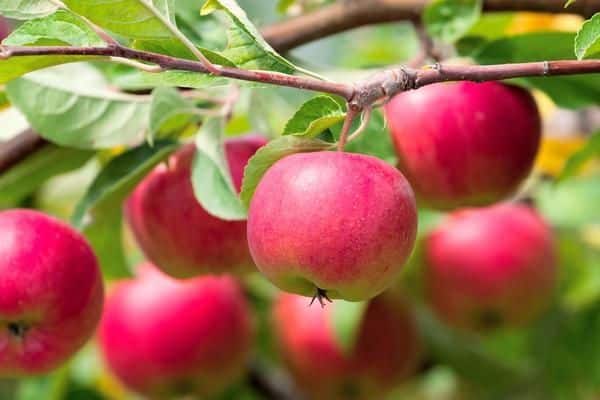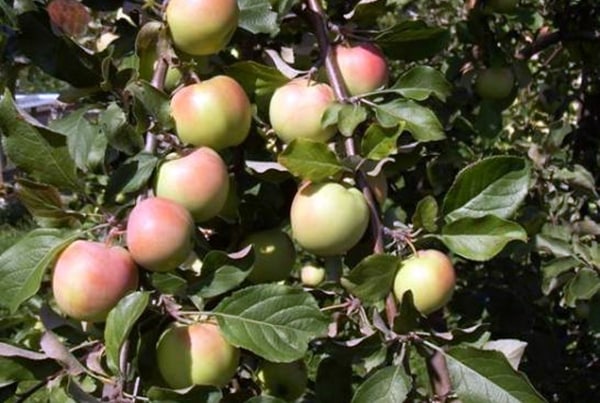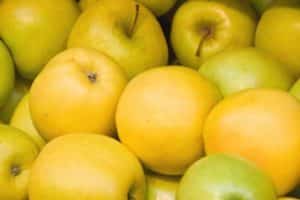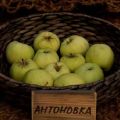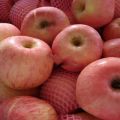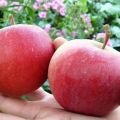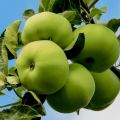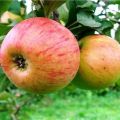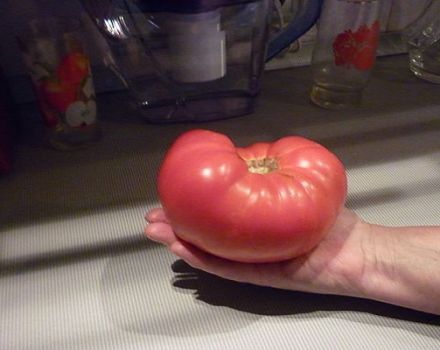Characteristics and description of Crimean apple varieties Sinap Orlovsky, Kandil and Gorny
The names of the Sinap apple varieties indicate that this type of fruit trees can be found in any corner of Russia. They grow in the gardens of the Crimea (Crimean synap) and in Siberia - in the south of the Krasnoyarsk Territory, in Khakassia. The history of selection begins with the Crimean variety of culture, it was grown already in the IXX century. Later, on the basis of its parental forms, S. I. Isaev, I. V. Michurin carried out breeding work to obtain new varieties that are resistant to low temperatures.
The advantages of this type
The characteristics of Sinap Orlovsky make it possible to grow this variety of apple trees in industrial gardens.
Description of its merits:
- winter hardiness;
- undemanding in care;
- large-fruited;
- regular fruiting;
- long-term storage of the crop;
- transportability of fruits.
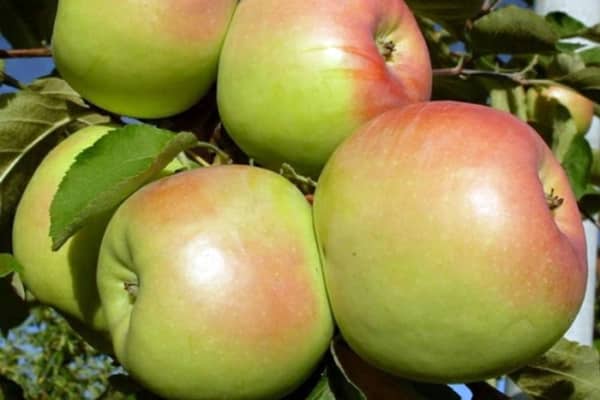
Growing places
Thanks to the work of breeders, Sinap apple varieties grow in different climatic zones. New improved varieties have mastered climatic zones with cold winters. Apple trees of Orlovsky and Northern Sinap are not uncommon in the gardens of the southern Urals, they are grown by residents of the Tver and Pskov regions, you can find them in the East Siberian region. These varieties grow in the Moscow region and in the Black Earth region.
The main characteristics of the apple tree
The parameters (crown size, height) of any fruit tree depend on the characteristics inherent in the variety and the degree of soil cultivation. The more fertile its composition, the more powerful the root system and crown.
Appearance
The height of the tree directly depends on the type of rootstock. In the classic version, Sinap Orlovsky is grown on semi-dwarf rootstocks. Such seedlings grow 4-5-meter apple trees. The use of vigorous rootstocks allows taller apple trees to be grown (5 to 6 meters).
The tallest trees (7 m) are grown from seedlings on clonal rootstocks. In areas with a high groundwater table, Sinapa seedlings are planted on dwarf rootstocks. Trees grow from 2.5 to 3 m.
| Name | Description |
| Branches, appearance | Strong |
| Branch growth | Up, the angle of departure is almost straight |
| Leaves (shape) | Oval flat or oval convex |
| Leaves (pubescence) | Present |
Yield
Fruiting is annual even in old apple trees. Yield indicators are above average. Good care allows you to get from 130 to 170 kg of fruits from one tall apple tree. The yield indicators of medium-sized apple trees are lower - 70 kg.
Taste qualities of fruits
In points, the assessment of the taste of Sinap apple trees is 4.3-4.7.Apples are not consumed immediately after harvesting; they must reach consumer ripeness for at least 1 month. At this time, they acquire a characteristic sweetness, softness, and juiciness.
The pulp of ripe apples Sinup contains about 9.5% sugars. The fruits are ideal for dietary nutrition: there are only 50 kilocalories in 100 g of pulp.
Apples that have reached consumer ripeness have a rich, balanced sweet-sour taste.
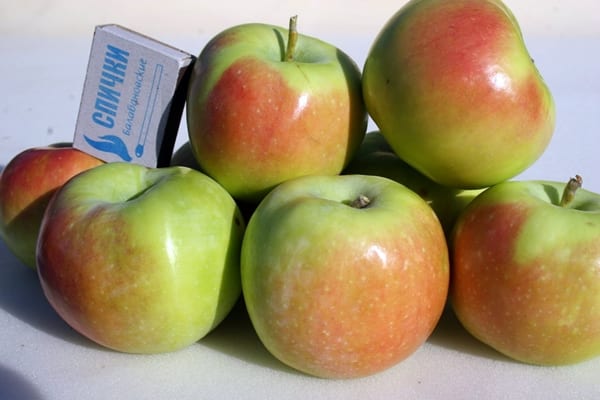
Frost resistance
Employees of VNIISPK from the laboratory of physiology of resistance carried out studies to study the resistance of tissues of shoots and buds to the action of low temperatures. The conditions were simulated artificially. Of all the varieties, Orlovsky Sinap showed itself better than others, its wood and buds did not suffer at a temperature of -42 ° C.
Disease susceptibility
Indicators of resistance to diseases are average. Leaves, fruits are prone to scab. An outbreak of the disease can occur in summer or autumn with high humidity. To preserve the harvest, prophylaxis with biological preparations (fungicides) is carried out:
- "Alirin";
- Fitosporin;
- "Hamane".

Varieties and description of varieties
For any climatic zone, you can find a suitable type of Sinap. They love this kind of apples for their appetizing appearance, delicate aroma, delicious taste, and keeping quality. Gardeners are attracted by the unpretentiousness of the culture, ease of care.
Almaty
Autumn is the ripening time for the apples of the Almaty Sinap. The shape of the fruit is original, it looks like an elongated oval. The apples are covered with a smooth and shiny skin that looks buttery.
During ripening, the fruits change color. At first, they are yellow-green with traces of a slight blush, and when the removable ripeness is reached, the color acquires saturation, darkens, becomes dark red.
On the cut, the color is not white, but cream. Light green streaks are visible on it, the structure of the flesh is loose, and the taste combines sweetness and a small proportion of acid. When ripe, apples have a slight chocolate aftertaste. Harvest in the first days of October, by this time the fruits acquire consumer ripeness. Fruits are stored for up to 3 months.

Northern
The apple tree of this variety has been known among gardeners since the 30s of the last century. When creating, the genetic material of Kandil-Chinese was used. Only after 5-8 years you can wait for the first harvests, although apple trees on a dwarf rootstock bear earlier fruiting, it comes on the 2nd, maximum on the 3rd year after planting. For 100% pollination, pollinators are planted - Slavyanka or Antonovka.
| Name of characteristics | Description |
| Weight (g) | 95-155 |
| The form | Cup-shaped, conical |
| Coloration | Yellow-green with brown-red blush |
| Subcutaneous points | Present, light tone |
| Pulp | With a high content of juice and fine grain structure |
| Taste | With spicy notes, sweet and sour |
The first days of October is the time for harvesting apples that have reached technical ripeness. Mature trees (15 years old) produce 170 kg of apples. Plucked apples gain their taste only during storage; at least 60 days pass before the onset of consumer ripeness.
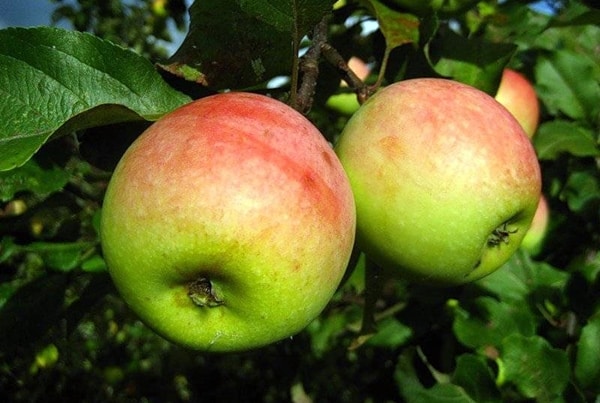
Khakassia
This winter variety is from the authors O. A. Plekhanova and E. I. Piskunov. Crossed Northern Sinap and Rossoshanskoe striped, both varieties are large-fruited. Apple trees are of medium size, they do not exceed 4.5 m in height, the crown acquires a narrow pyramidal shape.
Skeletal branches are directed upward at an acute angle. The Khakass variety withstood the test of the harsh winters of 2004, 2005 and 2006, showed excellent resistance to dense frosts, it does not grow out and is not susceptible to winter drying.
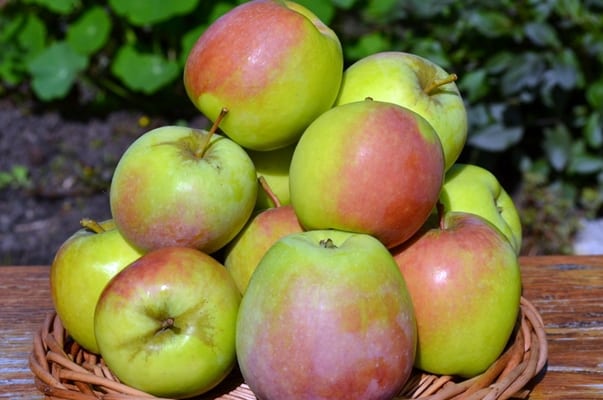
About 60 kg of apples are removed from an average tree. All fruits are commercial, their characteristics:
- weight (average) 170 g, maximum - 270 g;
- the skin is yellow-green, there are raspberry stains;
- oval shape;
- dense structure, juiciness;
- 4.5 points - taste assessment.
The apples are firmly attached to the stalks, there is no shedding. Ripen late. Harvesting should be carried out before the first serious frost, the fruits after sub-zero temperatures lose their juiciness. The apples are kept in the cellar until May.
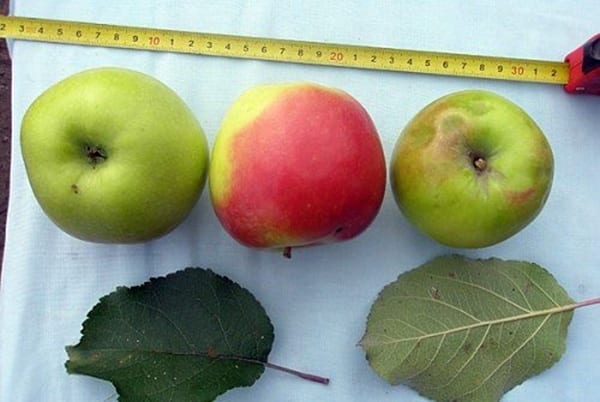
White
The history of selection is not described, the historical homeland is Crimea. The variety is late autumn, it is characterized by abundant and long flowering. The trees are not tall with compact crowns. Skeletal branches are covered with yellowish bark with a gray bloom.
A larger percentage of the yield is formed on ringlets, partly on fruit twigs. The size of the fruits is leveled, the average weight is 130-150 g, the apples are cylindrical. They are covered with a thin white-green skin, there is a light waxy coating and a blurred blush.
Not dense, fine-grained pulp contains a large percentage of juice and sugars. The aroma is weak, the taste is sweet and sour. The period of technical ripeness begins in the last days of September.
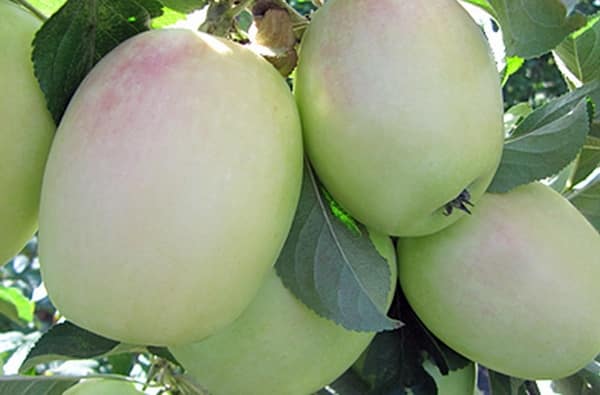
Benefits of White Sinup:
- good immunity to diseases (scab, powdery mildew);
- does not suffer from returnable spring frosts;
- frost-resistant;
- drought-resistant;
- apples lie until April.
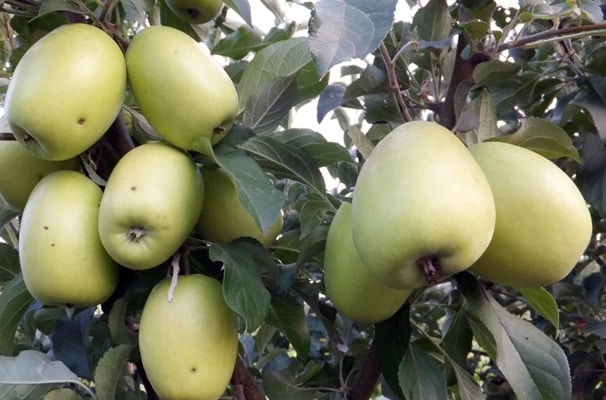
Mountain
Altai variety, disease-resistant, winter-hardy. The trees are medium-sized with a rounded, sparse crown.
| Fruit (characteristic) | Description |
| Weight | 90-100 g |
| The form | Conical, cylindrical |
| Ribbing | Present, weakly expressed |
| Peel (color) | Golden yellow |
| The presence and color of blush | Yes, raspberry |
| Pulp (cut color) | White |
| Pulp structure | Fine-grained |
| Taste qualities | Sweetness plus light sourness |
Apples are stored almost until mid-spring.
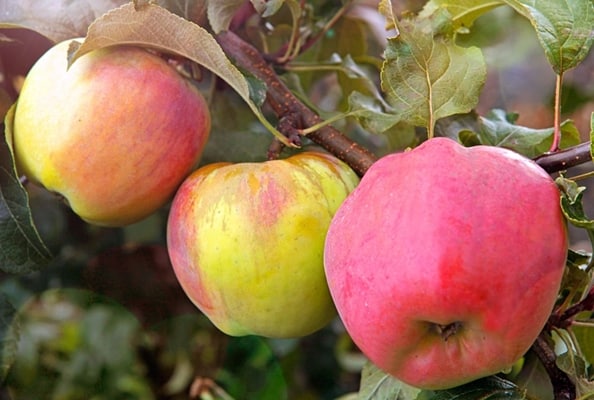
Orlovsky
The variety has been in use since 1955. Received from the forms: Memory Michurin, Northern Sinap. Recommended growing regions: Chernozem, North-West, Central, Middle-Volga and some regions of Belarus.
Productivity is increased with the help of pollinating varieties:
- Welsey;
- Pepin Saffron;
- Antonovka Ordinary.
The first harvests from Orlovsky are expected for at least 4-5 years. The harvesting period for fruits that have reached removable ripeness lasts from mid-September to October.
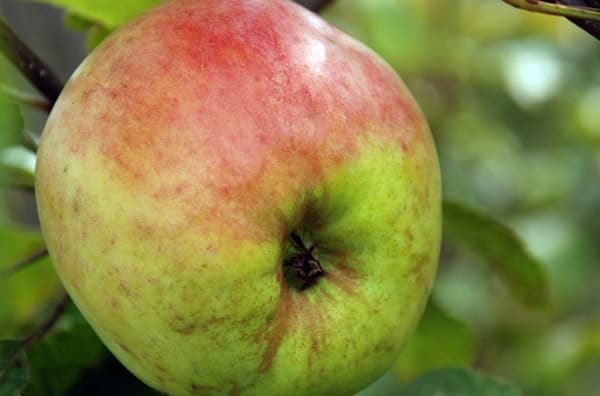
According to statistics, up to 70 kg of apples are harvested from one adult apple tree per season, their characteristics:
- weight (g) - 180;
- color is light yellow;
- subcutaneous points are light;
- the pulp tastes good, it is juicy with a weak aroma, creamy on the cut;
- lie for 6 months;
- sweet and sour taste is rated at 4.7 points;
- the shape is rounded-conical, the upper part is beveled.
Sinap Orlovsky shows good winter hardiness.
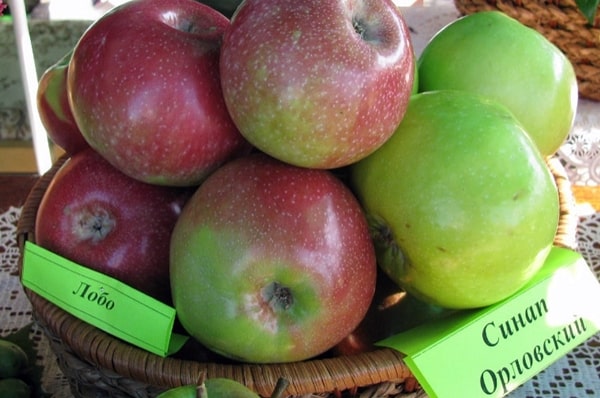
Sarah
Productive variety for southern gardens, large-fruited. The apples are beautiful, their weight is from 100 g. When removed, the skin color is yellow-green, later - golden. Long-term storage - plus varieties, apples lie until next summer.
The disadvantage is low winter hardiness, Sinap Sary does not tolerate the climatic conditions of the Central zone of the Russian Federation. It freezes even in the Stavropol Territory. It begins to fructify late (in the 15th year).

Qandil
Apples ripen from late August to mid-September, Kandil belongs to the group of late-ripening apple varieties. Trees grow slowly and are classified as vigorous (6 to 7 m). The crown is beautiful, pyramidal. Place of fruit formation:
- fruit twigs;
- spear;
- ringlets.
Sinap Kandil is a Crimean, large-fruited variety. The mass of the apple (average) is 120-140 g. The apple has an elongated, rounded-conical shape. It is covered with a smooth, pale yellow skin with a blurred red blush. The color of the subcutaneous points is green. The flesh of the apples is creamy rather than white. The taste (4.4 points) is sweet and sour.

Kandili needs pollinators:
- Reneth of Orleans;
- Sarah Sinup;
- Rosemary White.
In the presence of pollinators, the yield of Sinap Kandili is 200-300 kg. Apples in the cellar are stored until spring, in a regular room until December.
Crimean
A popular type of Crimean apples.In addition to Crimea, these apple trees are grown in the Krasnodar Territory, Ingushetia and Ukraine. The height of fruit trees depends on the rootstock, its spread is from 3 to 5 meters. Flowering and fruiting of apple trees takes place on annual shoots and fruit twigs.
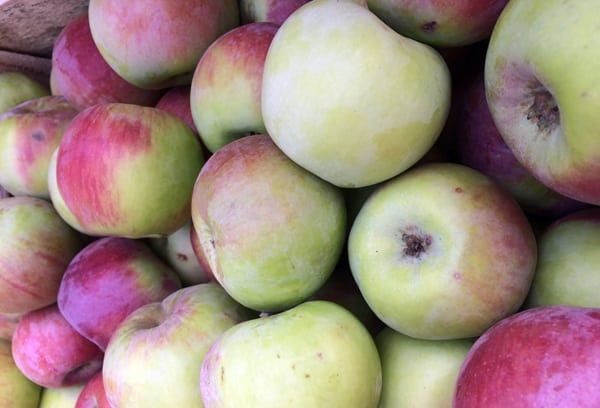
When to plant and how to care for a tree
Sinap seedlings are planted from March to April in spring, from September to October in autumn. More precise dates depend on the geographic location of the garden and the climate. The pit is dug 3-4 weeks before planting, its dimensions are 90 x 90 cm.
The sod is removed and placed in a pit, laid with its roots upward on the drainage from gravel (crushed stone). The soil taken from the upper layer is enriched with organic matter and fertilizers containing phosphorus and potassium. Their list:
- humus at least 2 buckets;
- compost about 1 bucket;
- ash about 0.5 kg;
- superphosphate 3 tbsp. l .;
- potassium sulfate 2 tbsp. l. without top.
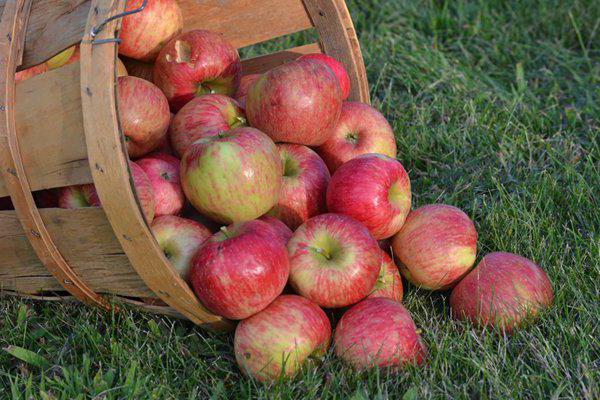
The third part of the well-mixed fertile mixture is poured onto the bottom of the pit, a low slide is formed from it. A high wooden stake (1 to 1.5 m high) is driven into its center. On the eve of planting, seedlings with an open root system are placed in water at night.
The apple tree is placed in a hole on the south side of the peg, the roots are straightened over the entire area of the mound. Pour and ram the soil, control the height of the root collar above the ground level. It should be from 5 to 7 cm. At the end of planting work, the trunk is fixed to a peg in 2-3 places, and the seedling is watered.
You can grow a fruitful, long-lived apple tree in the garden with proper care, it includes:
- watering;
- pruning;
- top dressing;
- disease prevention and treatment;
- processing of the aboveground part from pests.
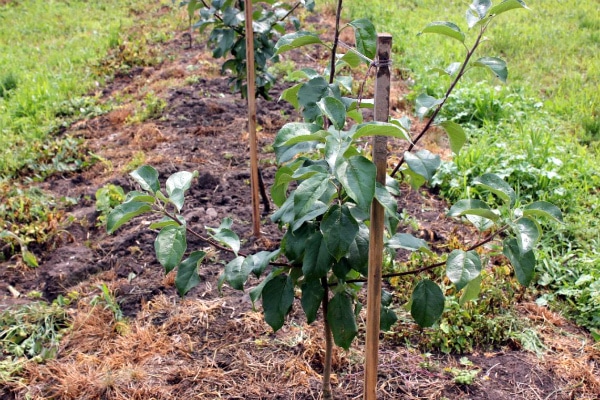
| Top dressing time | Fertilizer name | amount | Mode of application |
| Spring, after the snow melts | Humus | ½ bucket | Bring in for digging |
| During the period of active swelling of the kidneys | Urea | 450 g | Spread on wet soil and rake to loosen |
| After flowering | Mullein infusion, superphosphate, potassium salt | 1 l, 2 tbsp. l., 3 tbsp. l. | Dilute in 10 liters of water |
The Sinap apple tree planted in the garden has been supplying the family with delicious apples for many years. When choosing a variety, you need to take into account the climatic conditions of the area.
